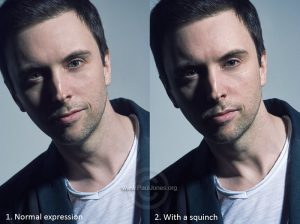“I’ve done multiple shoot days with Paul now, and he always manages to produce something special. His easy going nature puts you at ease straight away, and he’s very good at directing expressions and poses to paint the subject in the best light.”
Jay
I’ll preface this post by crediting professional headshot photographer Peter Hurley as the inspiration. I’ve been an admirer of Hurley for some time. Check out his video and the link to his website below.
As a people photographer, one of my main aims is to make the person who stands, sits or lies in front of my camera look good. To look endearing, attractive, self-assured and full of confidence.
I’m going to pass on one simple tip that can help with this, and if you get it right, can transform ‘Mr Normal’ into ‘Mr Cool’. Introducing ‘the squinch’…
The squinch
Hurley may have coined the term ‘squinch’, but I believe that some people have known about it for some time. It’s basically a half-squint of the eyes that can portray extreme confidence. If I think of my movie hero Clint Eastwood, how often do we see his self-confident half squinted eyes filling the frame in movies like ‘A Fistful of Dollars’, ‘The Good, the Bad and the Ugly’ and ‘The Outlaw Josey Wales’?
Confidence comes from the eyes. Look at other photos of movie stars and celebrities and you’ll start noticing many of them now adopting the squinching technique. These people are paid to look good in front of the camera, so if it works for them it can work for anyone.
The technique
At the start of a photoshoot, when the subject is feeling a little nervous, the natural expression can sometimes be a little ‘deer-in-the-headlights’ – tense and uncertain. That’s when the coaching comes in to build rapport and to help the person to relax and be comfortable around you. There’s much more to photographing people than knowing how to setup studio lighting or knowing what f/stop to use. I will often spend time talking about facial expressions and then introduce the concept of squinching, even showing some example photos saved on my tablet. Then it’s usually a question of ‘shall we give it a try?’ It sounds more complicated to explain than it actually is:
- I ask the person to look at me, relax their eyes and then slowly raise up the lower eyelid, so that they are giving me a half squint.
- I often then follow this by asking them to give me a very slight half-smile or smirk of the mouth.
Ask them to practise this a few times before you take a few photos. If you then show them the photos on the back of the camera or laptop screen they are often amazed at the difference. That was certainly the case with musician/singer Jay in the examples below from our first shoot together. When I asked him if he had heard of squinching he was full of curiosity to try the technique. We’ve now worked together on follow-up shoots and he can pull a squinch without thinking about it.
I mentioned Peter Hurley at the start. Watch his videos on Youtube and check out his website at PeterHurley.com.
Click the ‘before and after’ image of Jay below to see it bigger and feel free to post comments and questions below. Thank you very much for reading.






Hi Paul, good advice – I can see how this works, because it makes the model look as though they are really concentrating on the viewer – giving more connection, and hence looking confident in doing so. I learn so much from your coaching and tips – thanks. Mel.
Hi Mel. Thanks very much for your comment. Much appreciated.